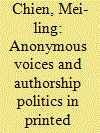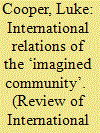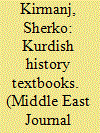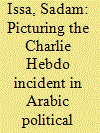| Srl | Item |
| 1 |
ID:
151479


|
|
|
|
|
| Summary/Abstract |
This paper analyzes two versions of a printed genealogy collated by the Hmub and Kam in Eastern Guizhou, who gave authority to claims of consanguine bonds. It focuses on how the main text of the genealogy and other intertextual practices can either attribute authority to the genealogies or undermine it. On the one hand, elite accounts of ancestors in the genealogies invent a strong ideology of consanguinity that directly contributes to the text’s authority. At the same time, however, the use of Chinese characters to represent the Hmub phonetic system coexists with the Hmub system of patronymy within the assemblage of the individual descendant names. In other words, Chinese characters represent nonpersonal phonetic symbols of the Hmub language. This in turn means that anonymous voices can emerge in other texts. The result is a shift in the nature of authorship from an overtly collective authority to a covertly diffused anonymity.
|
|
|
|
|
|
|
|
|
|
|
|
|
|
|
|
| 2 |
ID:
111488


|
|
|
|
|
| Publication |
2012.
|
| Summary/Abstract |
This article examines the ways in which young Canadians represent the 'the War on Terror' in their narratives. I explore how a hegemonic nationalist narrative enters into this representation in different ways and positions itself in a dynamic tension with the USA, at times eliding the difference and at times affirming it. I illustrate that these students do not simply tell the narrative of the war, but use the deixis of 'we/us/our' or 'them/they/their' in a way that constructs multiple imagined communities. I argue that these presumably benign representations of Canadian involvement in the war produce banal nationalism that excludes 'others', and binds human imagination into a framework that works against critical thinking.
|
|
|
|
|
|
|
|
|
|
|
|
|
|
|
|
| 3 |
ID:
166622


|
|
|
|
|
| Summary/Abstract |
The article aims to shed light on mosque communities in Russia through the example of mosques frequented by Moscovites and by Central Asian migrants. I will make use of Anderson’s theoretical framework of ‘imagined community’ in analysing the material presented in the article. The main argument is that there are no real mosque communities and rather that the sense of community formed around mosques is imagined. There are nevertheless a variety of networks, groups and institutions within and around mosques. The article is based on fieldwork conducted in 2016 and 2017.
|
|
|
|
|
|
|
|
|
|
|
|
|
|
|
|
| 4 |
ID:
139587


|
|
|
|
|
| Summary/Abstract |
Benedict Anderson's Imagined Communities has long been established as one of the major contributions to theories of nations and nationalism. Anderson located the rise of national identities within a long-evolving crisis of dynastic conceptions of identity, time, and space, and argued print-capitalism was the key cultural and economic force in the genesis of nations. This article offers a critical appropriation and application of Anderson's theory through two steps. Firstly, it evaluates the conceptual underpinning of his approach through an engagement with recent scholarship on the ‘theory of uneven and combined development’. The fruits of this interchange provide a deeper analytical framework to account for what Anderson calls the ‘modularity’ of national identity, that is, its universal spread across the globe. Modularity is now reconceptualised as a product of combined development with its causal efficacy derived from the latent dynamics of a geopolitically fragmented world. The latter gave shape and form to the new national communities. Secondly, this revised framework is applied to the emergence of Chinese national identity in the late nineteenth century. This allows Chinese nationalism to be recast as an ideological amalgam of indigenous and imported elements that emerged out of the crisis-ridden encounter between Imperial China and Western imperialism in the nineteenth century.
|
|
|
|
|
|
|
|
|
|
|
|
|
|
|
|
| 5 |
ID:
132934


|
|
|
|
|
| Publication |
2014.
|
| Summary/Abstract |
This article reviews the history and social studies textbooks used in Kurdistan Regional Government (KRG) schools in terms of their contribution to the construction of the Kurdish/Kurdistani national identity. The article also examines how the KRG's views of the Other are expressed in these textbooks
in order to reveal the discourses, categories of differences, assumptions, and views about these concepts, as well as the attempts made through the text- books to answer the question of what it means to be a Kurd or a Kurdistani. As with nation-building projects elsewhere, KRG school textbooks are part of a strategy to create an "imagined community," and are intended to strengthen the process of creating a Kurdish/Kurdistani nation-state within an Iraqi nation-state.
|
|
|
|
|
|
|
|
|
|
|
|
|
|
|
|
| 6 |
ID:
147388


|
|
|
|
|
| Summary/Abstract |
This article investigates how the Arabic political cartoons picture the mocking cartoons of the Prophet Muhammad by the French satirical Charlie Hebdo magazine.1 It is noticed that the cartoons utilize the Charlie Hebdo incident as a locus to deconstruct the unjustness and bias of the Arabic leadership and the international community in their dealing with some Arabic political issues. The surveyed cartoons also used the Charlie Hebdo incident as a locus to formulate the Palestinian “imagined community” (Anderson, 1991). I argue that the surveyed cartoons use the strategy of “differentiation” (Meyer, 2000) based on the self vs. other dichotomy to establish this deconstruction and imagined community. The study uses the semio-linguistic and visual rhetorical tools (Barthes, 1972), and self-categorization (Turner, 1987) to achieve this deconstruction, through an analysis of semiotic-discursive aspects of a small corpus of Arabic political cartoons. The findings indicate that promoting a discourse of fear and danger toward the inside and outside actors is what constitutes this self-other-based identity.
|
|
|
|
|
|
|
|
|
|
|
|
|
|
|
|
| 7 |
ID:
113339


|
|
|